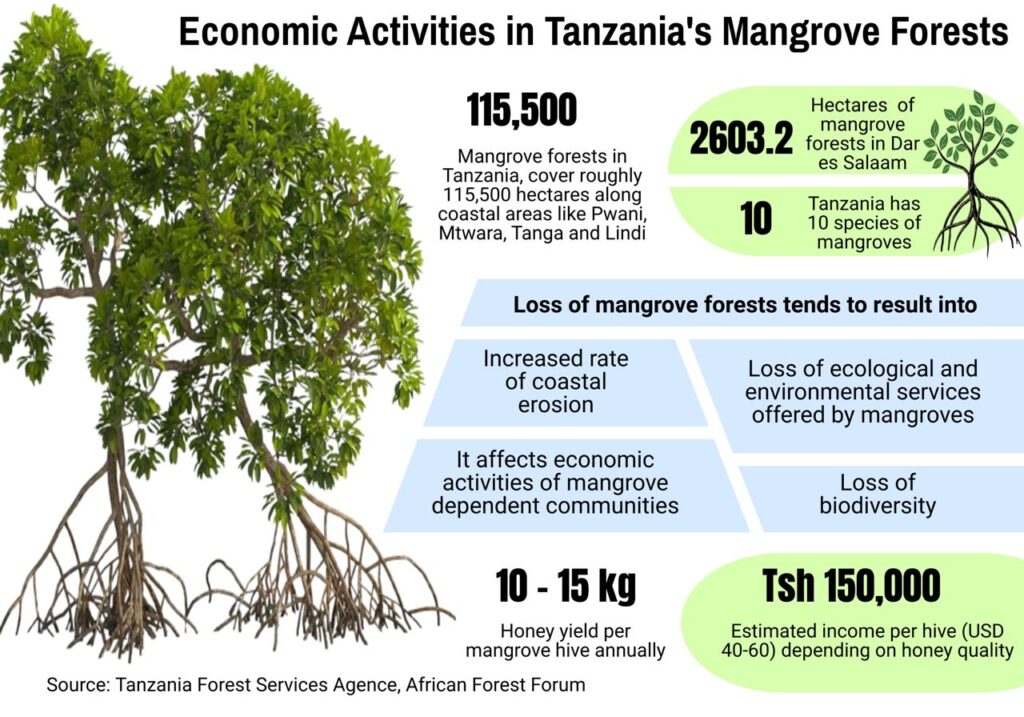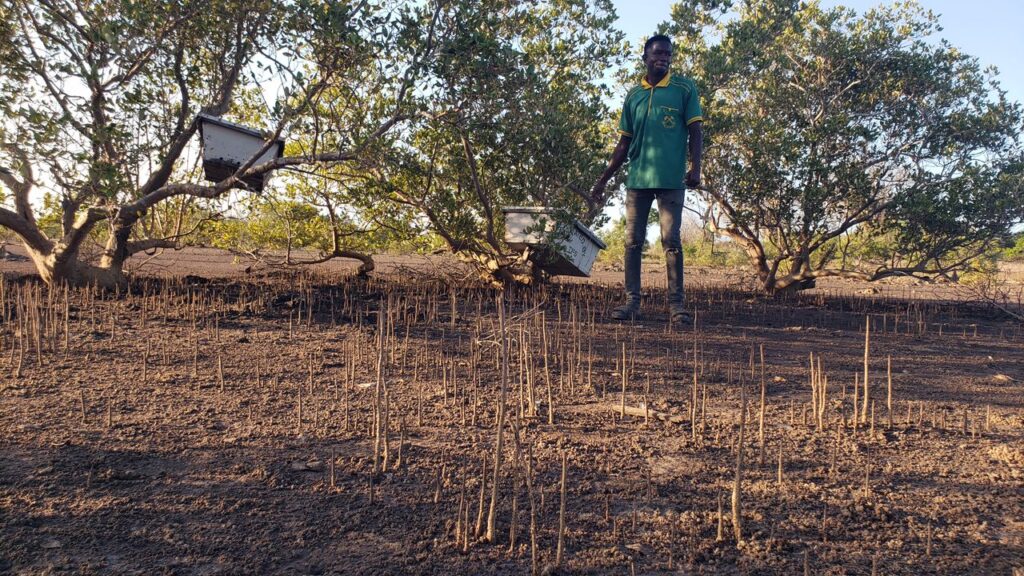By Haika Kimaro
Mtwara. In a small coastal village, Msimbati, nestled along the Indian Ocean in Mtwara Region in southern Tanzania, lies a precious ecosystem: the mangroves.
Upon arriving in Msimbati around 9 a.m., I noticed groups of people in animated discussions. Curious, I approached to find out what they were talking about.
Contrary to my thoughts that they were just making small talk, they were discussing progress of their honey business. They harvest honey from beehives placed in the mangroves, which thrive in this coastal village.
Apart from initiating bee keeping, Msimbati is reputed as one of areas with pristine beaches in the country.
Mangroves surround the beaches in Msimbati, an important ingredient in marine biodiversity. This is the story of how a simple yet powerful idea-keeping keeping bees in the mangroves – became the village’s solution to saving their environment and securing their future.
Mangrove forests in Msimbati Village are critical to the local environment, providing numerous ecological and economic benefits. The conservation of these mangroves is essential for maintaining healthy ecosystems, protecting coastal areas from erosion, and supporting marine biodiversity. Mangroves also create an environment conducive to beekeeping, a sustainable livelihood that is gaining popularity in the area.
The mangrove ecosystem supports a rich variety of plant species, which flower and provide nectar for bees. Mangrove species like Avicennia and Rhizophora are valuable for bees, offering food sources that enable honey production.
The conservation of mangroves ensures that bees have a thriving, pollution-free environment to forage. Mangroves filter pollutants and maintain water and air quality, providing a clean habitat for beekeeping. As the mangroves were cut for timber and building materials, the environment in Msimbati suffered. Environmentalists stepped in to educate the villagers on the importance of the mangroves and suggested beekeeping as a sustainable alternative.
After they were educated on the significance of the trees and how to protect them while also earning their livelihood, the villagers decided to use the mangroves as a bee farm.
Mr Mustafa Issa, a father of two and fisherman, was among the first villagers to embrace beekeeping. He explains how environmental experts helped save the mangroves.
In an interview, Mr Issa narrates how education they received from environment experts helped to save the mangrove forests around their village. He says, “People were cutting mangroves for timber, and we started noticing a decline in fish. We didn’t know the connection until the experts showed us that the loss of mangroves was directly related to the reduced fish stocks.” He adds that,
“We asked how we could reverse the damage, and they taught us that beekeeping could not only save the mangroves but also provide a source of income.”
By protecting the mangroves, the community ensures the ongoing productivity of this ecosystem, which directly supports beekeeping as an income-generating activity. Beekeeping has emerged as a sustainable alternative livelihood for the people of Msimbati Village, complementing traditional activities like fishing.
It offers several advantages. Beekeeping provides a reliable income source that reduces dependence on fishing or cutting mangroves for charcoal production. Honey is a high-value product that can be sold locally or exported, offering economic benefits without depleting natural resources. The money earned from beekeeping is more than what villagers made from cutting mangroves.
Issa recalls how he used to sell mangrove timber for around Sh8,000 (USD 2.9) to Sh9,000 (USD 3.31) per bundle, but now he earns Sh10,000 per liter of honey. “In a month, I earn at least Sh400,000 (USD 147)—far more than I ever made from selling building materials,” he says.

The profits from beekeeping have transformed the villagers into protectors of the mangroves. Mr. Issa says, “I was a fisherman for over 10 years before switching to beekeeping, and I now earn more from honey than I did from fishing,” noting that he harvests between 40 and 50 liters of honey every six weeks.
Beekeeping is an environmentally friendly practice that aligns with conservation goals. It requires minimal land use and does not harm the mangroves, making it a sustainable livelihood option for communities engaged in conservation efforts.
In many communities, beekeeping is particularly accessible to women, giving them an opportunity to participate in income-generating activities. This contributes to improved livelihoods for households and promotes gender equality.
The integration of mangrove conservation and beekeeping in Msimbati Village has led to tangible improvements in livelihoods by creating a sustainable cycle. Mangrove conservation ensures that bees have access to diverse floral resources, leading to higher-quality honey production.
The mangroves provide a unique floral source that contributes to the production of mangrove honey, which can be marketed as a specialty product with a higher value. Honey production, processing, and sale provide income to local families.
By adding value through the production of honey by-products such as beeswax candles, and cosmetics, communities can further enhance their income.
As beekeeping becomes a more profitable and sustainable livelihood, it reduces the need for unsustainable practices like cutting mangroves for firewood or charcoal. This shift helps in the long-term conservation of the mangrove ecosystem, as fewer resources are extracted destructively.
Another villager, Mr Idriss Hassan, reflects on how their view of mangroves has changed, “We used to cut mangroves for building, but after learning their importance to marine life, and we now protect them.” He says, “Mangroves are now a source of income. We have set up rules to protect them.”
Mrs Fatuma Khamisi, also involved in protecting the mangroves, shares how beekeeping has improved her family’s nutrition. She says, “My children now have tea before school. In the past, I couldn’t afford sugar, but beekeeping has improved my earnings, allowing me to buy essentials for my family.”
Mrs Khamisi previously sold fish, but she now supplements her income with honey sales. She explains, “I still sell fish, but honey brings in more money.”
Mrs Mwanaheri Mwinyi, another villager, stresses the dangers of mangrove deforestation. “Cutting mangroves caused floods from ocean waves, but things have improved now that we protect the trees.”
Mr Boniphace Michael from the Indian Ocean Conservation Alliance (IOCA) says they have been educating villagers about marine conservation, working closely with experts from the Marine Park. He says, “Protecting mangroves is linked to other ecosystems like coral reefs.
When one ecosystem is harmed, others suffer.” So far, IOCA and the villagers have planted 3,000 new mangroves, and they continue to raise awareness about conservation.
The Msimbati Village Chairman, Mr Issa Nampalanguka, recalls a disaster in 2018 when ocean currents eroded gas infrastructure and homes in the village. The army had to intervene, and since then, everyone has become more vigilant about protecting the mangroves.
He says, “We work with IOCA to plant more mangroves for beekeeping, and some villagers have even used TASAF funds to start their beekeeping ventures.”
Dr Redfred Ngowo, a senior conservator at the Ruvuma Marine Park, explains that while many villagers rely on the mangroves, they are required to obtain permits for sustainable use. He adds that they have also replanted mangroves in abandoned salt farms.
Dr Ngowo concludes, “We don’t have enough resources to support all the organizations working to protect marine environments, but we do our best to collaborate.”
Southern Tanzania’s coastal communities have now become model for conservation and sustainable livelihoods due to their innovative, community-driven approaches to resource management.
By embracing conservation measures, sustainable fishing practices, and alternative livelihoods like eco-tourism and beekeeping, these communities have shown how protecting the environment can go hand-in-hand with securing economic benefits.
Their success demonstrates the power of local action, supported by education, collaboration, and a deep connection to the natural world, in fostering long-term sustainability.



Hi friends, how is everything, and what you wish for to say regarding this post, in my view its in fact amazing in support of me.